This is the comprehensive introduction to B2B SEO—so you might want to read this one over lunch. Here’s the executive summary:
- Your 2024 B2B SEO strategy should give attention to content helpfulness, triage, and the use of AI.
- Businesses don’t Google things, people do. Whether it’s B2B or B2C, your SEO strategy needs to be about the people you’re trying to reach.
- Your B2B SEO strategy should answer 3 questions:
This guide will give you the best practices you need to build your own B2B SEO strategy.
B2B SEO in 2024: AI, helpfulness, and triage
Google rolled out four core updates in 2023, along with a major helpful content update (i.e., an update to give pages with helpful content on them preference in SERPs). The fundamentals of B2B SEO haven’t changed since our 2023 update, but one major change has happened when it comes to execution: the advent of widely-available generative artificial intelligence. It is now easier than ever for B2B marketing teams to produce vast libraries of AI-generated content, which means a strategic SEO leader should take the implications into account when planning and producing content for SEO.
We’ll be discussing the practical aspects and implications of AI, content helpfulness, and triage in depth throughout this year, but the most important things to understand when it comes to forming a B2B SEO strategy in 2024 are:
Update your model for prioritizing content
There are always going to be more content ideas to pursue, but as Google continues to scrape content and drive down clicks, even the high-volume, high-relevance keywords aren’t as lucrative to chase as they used to be. At Overthink Group, we help our clients create models for prioritizing their content calendars based on relevance, potential traffic, internal business objectives, timeliness, and other factors. If you don’t already have one, develop a quantitative model for triaging content production. Not only will it help you make the most of your time, but it’ll also help you justify your decisions to internal stakeholders.
Don’t let AI make you look stupid
While GPT4 can mimic human writing to an impressive degree, it isn’t an expert on any subject matter in particular. Generative AI is trained on content that is already out there, and it’s usually in the dark when it comes to very recent events and developments. If you want to contribute something new to the conversation, you need to develop and articulate a point of view. As of 2024, that’s still human work.
Furthermore, generative AI is prone to hallucinations: accidentally making false claims. For some low-stakes, generic content, this is no big deal (after all, humans can slip up sometimes, too). But if your AI-generated content isn’t being thoroughly fact-checked by a human editor, you could end up publishing content that gives bad advice, makes false claims, or even misrepresents your own products.
Use AI like a game theorist
Generative AI is available to everyone now, which means everyone has instant access to AI-quality content. Strategic B2B SEOs will look for ways AI can make their teams more effective while also understanding that their competitors are doing the same thing. Human-written (good) content still tends to outrank AI-generated content in search, so while AI can certainly help you speed up your rate of content production, it can also turn your content strategy into a race to the bottom. Smart content strategists will blend human and AI effort in such a way that increases efficiency but doesn’t leave them vulnerable to the competition.
Google’s trash is your treasure
The internet is already rife with thin, low- or no-value content (let’s call it what it is: garbage) written by humans. With generative AI widely available, now that kind of garbage can write itself. If you’re trying to rank for search terms related to a certain topic, browse the current top results. If the results all feel like generic re-hashes of each other without any branded insight, take it as an opportunity to outrank the incumbents.
Citable > sharable
If you want influencers to promote your content and other writers to link to it, you need to create the kind of content that experts want to reference. You can do this by publishing original research, frameworks for decision-makers to use, and tactical resources that your audience keeps bookmarked. Creating authoritative, evergreen content is a win for SEO (both in traditional search engines as well as more social search engines like YouTube and TikTok).
Just let AI write your meta descriptions
One of the chores that comes up when teams do a massive cleanup of their content libraries is populating meta description text. If this task comes across your desk, do yourself a favor and let AI write mass meta description text. Google has been rewriting the majority of link description text for years now, so don’t waste any creative energy on this. This is the kind of thing AI was made to do.
NOTE: We update this guide for major updates in the B2B space for beginners, but if you want more advanced, as-it-happens SEO tips, subscribe to our content strategy newsletter. =)
What is B2B SEO?
SEO (search engine optimization) is the science of getting your Web pages to show up when people use search engines. Which means,
B2B SEO = the science of reaching professionals via search engines
That could include:
- A CMO searching for “omnichannel marketing”
- A startup founder searching for “HR software”
- A facilities director searching for “sound masking”
- A surgeon searching for “most comfortable surgical gloves”
On-page, Off-page, and Technical SEO

There are three general categories of SEO: on-page SEO, off-page SEO, and technical SEO.
On-page SEO is everything that goes into making a certain page rank. This mostly deals with the content itself that you’re serving up—which is why some people call it “content SEO.” When you’re talking about keywords, user experience, titles and meta descriptions, you’re talking about on-page SEO.
Off-page SEO is everything that happens on other Web pages that helps a certain page rank in search engines. There are several elements of off-page SEO, but links are the most important, and therefore the most commonly talked about.
Technical SEO is (generally) the behind-the-scenes stuff. It’s making sure your website is friendly to the technology that powers search. When you hear terms like “schema,” “AMP,” and “SSL,” you’re in technical SEO territory.
There’s a good deal of overlap here. For example, the faster your page loads, the better it will rank in Google—that’s both on-page and technical SEO.
Or for another example, comprehensive, long-form content tends to include more keywords and get more links from reputable sites. That’s both on-page and off-page SEO.
Although B2B companies should understand technical SEO, it’s not really B2B-specific. So this article pays much closer attention to on- and off-page SEO.
B2B SEO vs. B2C SEO

SEO is SEO. Whether you’re trying to reach customers, businesses, or just trying to get strangers to read your musings, the same basic principles apply:
- Discover what people are searching for.
- Create something that can satisfy them.
- Convince Google that what you created can satisfy them.
You’ll do this over and over in B2B SEO.
However, because of how marketing works in the B2B world, you can expect a few particularities in B2B SEO that you wouldn’t necessarily count on in other spaces.

1. B2B SEO needs to reach multiple decision makers
Because B2B purchases tend to be significant, long-term investments, more people need to weigh in on the buying decisions. Practitioners, managers, and executives will each approach the decision with very different problems in mind—so you can expect them to be searching Google for very different queries.
That means that a B2B company will need to have pages optimized for:
- Answering tactical questions from practitioners (e.g., “How to increase email open rates”)
- Answering high-level questions from executive stakeholders (“how to scale marketing teams”)
- Answering a wide range of questions for managers (“email marketing best practices,” “best email marketing software,” “HubSpot vs ActiveCampaign,” etc.)
And depending on what you’re selling (and whom you’re selling to), that range of personas can get rather wide. I’ve worked with clients targeting as many as nine different personas when it came to organic search—it’s possible that you will need to target more.
2. B2B SEO relies on low-volume keywords
Every month, there are more than 60,000 Google searches for “window air conditioner.”
But you know how many times a month people Google “HVAC automation system”? About ten.
The B2B space is smaller than B2C, and that means your SEO strategy needs to account for high-value, very low-volume keywords.
Keyword = what someone types into a search engine. Also called “search term,” “search query.”
This can be especially difficult for people with a lot of experience in B2C SEO. If you’re playing in a market with keywords that get more than 10,000 searches every month, then it can be easy to overlook the most important B2B searches happening in your industry.
A good B2C SEO can spend 40 hours on a blog post that brings in 30,000 new organic search visits every month—and not need to do a great deal of keyword research. But a B2B SEO needs to spend a lot more time sourcing and grouping related keywords into topics that can be addressed with a single blog post—and even then, that post might only bring in a hundred new organic views every month.
3. B2B SEO converts less organic traffic
Of the 60,000 people Googling “window air conditioner,” a few thousand are going to buy a unit.
But I bet zero property managers purchase a building automation system right after they’ve Googled “HVAC automation” for the first time.
B2C SEO has more search volume and fewer decision-makers—which means it’s far likelier to convert a visitor to a customer. But the B2B space has a much longer sales cycle, more stakeholders, and higher prices.
That means your B2B SEO content shouldn’t be built (nor expected) to convert cold organic visitors into sales. There may be some high–purchase intent searches in your industry that are the exception to this rule, but for the most part, people Googling in the B2B space aren’t ready to buy anything yet. They’re looking for the tools and information they need to do their jobs.
That may sound like a downer, but it comes with an upside: B2B SEO tends to have less ecommerce competiton. If you’re selling a solution to consumers, you’re up against Amazon, Walmart, eBay, and other ecommerce giants when people Google your product category. Ecommerce SEO has some of its own best practices. You optimize a product page differently than how you’d optimize a blog post. B2C SEOs usually need to take these into account when making their strategies.
But there’s less ecommerce competition in the B2B space (a nice side-effect of longer sales cycles and higher prices). That means you tend to be competing with content and home pages more so than ecommerce product pages. B2B is a bit simpler on this front.
4. B2B SEO emphasizes thought leadership and branding
Because B2B searchers aren’t likely to convert on their first visit, B2B SEO tends to be more about establishing the brand in the searcher’s memory than getting them to make a purchase.
That means B2B SEO isn’t just about making sure your website shows up when people search for your product category. It’s about getting your audience used to seeing your website in the SERPs when they Google questions related to their job.
SERP = “Search engine results page,” or the page that you see immediately after you Google something.
You know, this:

(We’re all familiar with SERPs, but there can be some variation in what they look like. We cover that in our guide to SERP features.)
A good B2B SEO strategy builds trust in your market. It shows the people you’re trying to reach that they can count on you to help them solve their problems.
How to make a B2B SEO strategy
If you’re responsible for writing an SEO strategy for your B2B company, where do you start? Here’s a step-by-step formula for writing an SEO strategy that wins traffic in your market. (And yes, we do this for our clients—so if you want a hand, we should talk.)
It’s incredibly easy to overcomplicate SEO. That’s why it’s good to start simple. At its core, a B2B SEO strategy answers three questions:
- What are our people looking for?
- How will we satisfy that desire?
- How will we convince search engines that we’re satisfying them?
The entire SEO industry is built around answering these questions. So we won’t answer them all in-depth here. Instead, let’s take a high-level tour through all three, with some specific dos and don’ts to keep in mind in the B2B space.
1. “What are our people looking for?”
SEO starts with understanding what people in your market are typing into Google and other search engines. You can rank for all kinds of keywords—but if nobody’s searching for them, they’re not going to do you any good.
We’ll look at a few practical ways to answer this question in a minute, but first let’s address the most important part of this question: “our people.”
To do B2B SEO right, you should already know who your market is. You’ll likely need to account for specific types of decision-makers, practitioners, and other stakeholders in the companies you’re trying to reach. This gives you an idea of what jobs you’re helping people do, which is the key to making sure you’re focusing on relevant search terms.
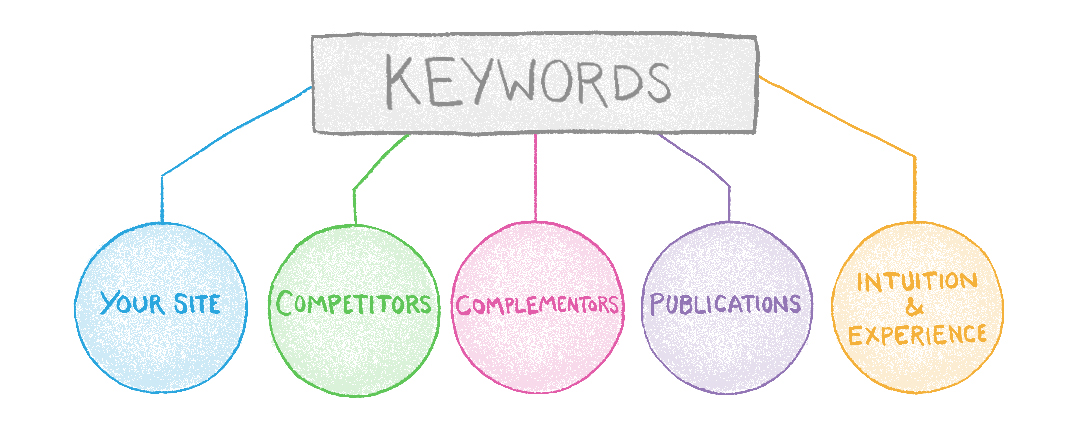
A few quick notes before we jump into this:
- Keyword research can go on forever. I enjoy it a lot, but it’s not for everyone. Keyword research gets dizzying after a while, and it will eat up all your content strategists’ time if you let it.
- You will need a paid keyword tool. We’ll look at some free tricks for finding ideas, but if you want to do real research, expect to pay for the right tools. Ahrefs, SEMrush, and Moz are popular tools to use—I tend to rely on Ahrefs for the best data and SEMrush for speed.
(No, that’s not an affiliate link. That’s an affiliate link.)
Determine which keywords you already rank for
First thing you want to do is get an idea of what you’re already ranking for. You can grab this data from the Google Search Console, or from your keyword tool.
1. Enter your own domain

2. Go to the organic keyword report
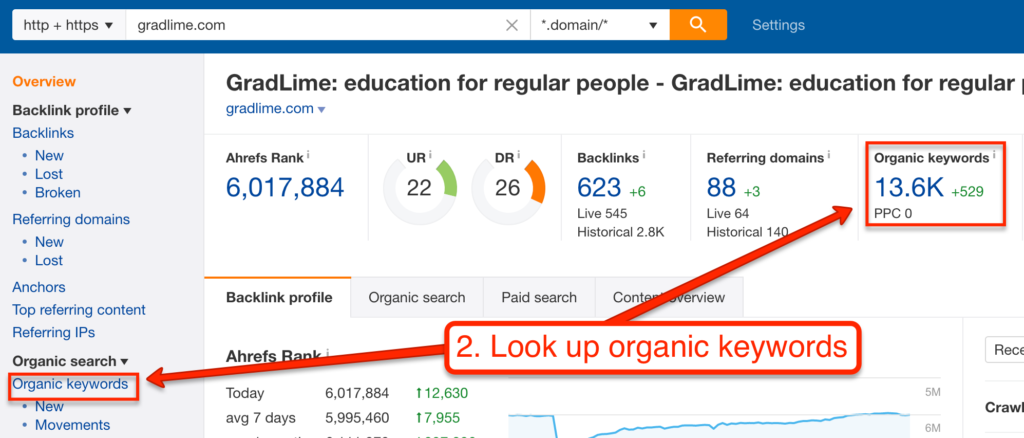
3. Export those keywords.

When you export that list, you’re going to want the keywords you rank for, the URL that ranks for each keyword, the position that URL ranks in the SERPs, and the keyword’s search volume.
Search volume = How many times a month people enter a keyword into search engines.
With this list, you’ll know where you’re showing up in the SERPs. This is important because you don’t want to create new content that competes with what you already have. If you rank at the bottom of page 2 for a certain result, you may not need to start from scratch—you might just need to brush up your existing content.
You’ll reference this list as you compare the keywords you rank for to what people are already searching for in the market.
Get keywords from your competitors
Do the same thing with your competitors’ websites that you did with your own. A good SEO tool will allow you to export all that data into a spreadsheet.
Get keywords from publications
Same story, different kind of website. Depending on your industry, there may be some publications in your niche that are attracting a lot of organic traffic. It doesn’t hurt to see where that traffic is coming from, either.
So for example, if you were trying to reach business leaders in the fintech niche, you would probably want to see what kind of keywords fintech blogs like The Financial Brand and Daily Fintech rank for.
Get keywords from complementors
Sometimes there are players in your space who aren’t competing with your product. But they are really hitting content out of the park. It’s important to get an idea of what they’re ranking for, too.
You don’t need to do this for every single complementor in your space. But if there’s a non-competitor whose blog is really popular in your market, you should find out what they rank for.
For example, if you’re in the content marketing game, you need to pull keywords from Buffer’s blog. (But good luck outranking them!)
Good old-fashioned intuition
Sometimes you just have a hunch that people are looking for something. Maybe it’s a frequently-asked question that you hear a lot in real life. Maybe it’s a problem that has kept you up at night, and you don’t think you’re the only one.
Intuition is a phenomenal source of keywords—but don’t stop there.
Plug those gut-instinct keywords into your SEO tool, and check out what sort of search volume they get. Export similar, related, and suggested keywords as well.
Ahrefs is particularly helpful on this front. I wanted to know what kind of stuff people were Googling on the topic of employee engagement surveys. So I looked it up in their keyword explorer.
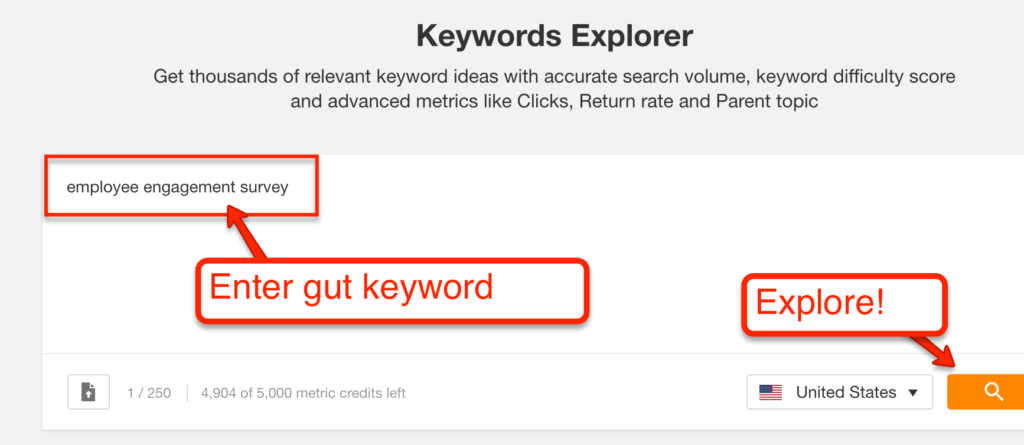
Turns out there are more than 3,300 related keywords that people are Googling:
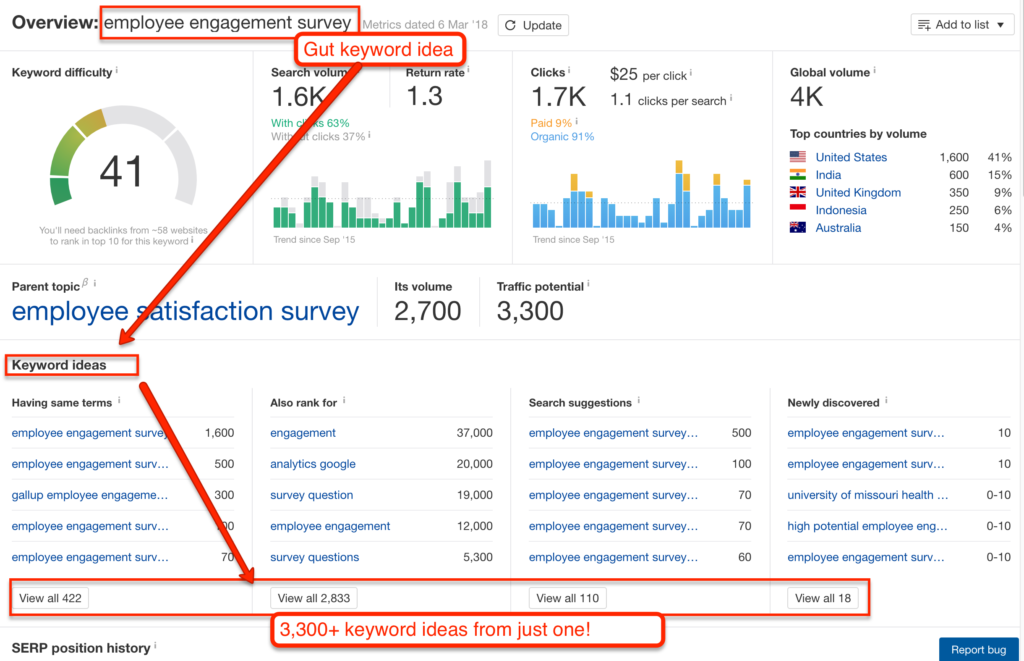
Vet your keywords, then group them by intent
If you’ve pulled all this keyword research from your industry, you’re probably sitting on thousands of keywords. Maybe even tens of thousands.
Time to whittle that sucker down.
First, throw out any keywords that don’t have anything to do with your market. For example, there are 37,000 monthly searches for “engagement”—but odds are those people aren’t looking for employee engagement resources. So I can throw that one out.
The real job here is to take inventory of what people are really looking for. The keywords just give you an idea of the vocabulary your market uses. You need to look past that, and start grouping these keywords by search intent.
Search intent = the objective someone has in mind when they search a certain keyword.
As you go through those keywords, take note of the specific intents that people have. For example, people looking for “best building automation systems” are probably on the hunt for multiple BAS options. People looking for “improve office air quality” are looking for tips to, well, improve the air quality in their office.
Best practices for B2B keyword research
By this point in the game, you’ll have done your homework. You’ll know how people find you, your competitors, and other players in your space. You’ve started wrapping your head around the kinds of things that your market is looking for when they use Google for work.
There’s a host of nuances to keep in mind when it comes to keyword research. But if you play by these best practices, you’ll be off to a strong start:
- Do NOT get lost in the weeds. Keyword research will take as much time as you set aside for it, and then some. But you can do effective, high-level keyword research quickly, too. Britney Muller at Moz says, “Keyword research doesn’t have to be a marathon bender. A brisk 30-minute walk can provide incredible insights—insights that connect you with a wider audience on a deeper level.” (Her 30-minute guide to keyword research is en pointe, by the way.)
- Group keywords by intent. You don’t want to waste time writing a new blog post for every single individual keyword. Instead, assign each keyword to a general search intent.
- Consider the difficulty. Most SEO tools will give each keyword a “difficulty score” of some sort. The lower the difficulty score, the easier it is to rank for the term. SEO tools make this score by weighing different factors on the currently-ranking content, like links, domain authority, etc. Factor this into the mix as you’re grouping keywords, so you can grab the low-hanging fruit.
- Prioritize relevance over search volume. Fifty highly relevant views can be far more valuable than 50,000 views from people who won’t even remember you.
- In fact, expect to chase low-search volume concepts. This is B2B SEO, so odds are good that your market is small enough for the truly golden keywords to have very low search volume.
2. “How will we satisfy our people?”
This is where it gets real.
You’ve determined what your market is looking for. Now it’s time to figure out how you’re going to give it to them.
Another way of asking this question is, “Now that we know what they want, what will we make for them?”
Like with keyword research, there’s a lot of nuance to explore beyond the scope of this post. But this will give you the gist of the most common ways to satisfy those searches.
Product category SEO
If you make commercial white noise machines, you should rank for “commercial white noise machine.”
If you make industrial-grade coffee grinders, you should rank for “industrial coffee grinder.”
This is the most obvious aspect of B2B SEO: do what you can to rank for your product category. There’s a lot to explore here, but you should at least make sure you’ve done the following:
- Add your product category to your home, pricing, and features pages’ <title> tags.
- Mention your product category in tandem with your brand name when you’re writing content—especially when you’re writing content that lives on another site. (It should definitely be in your “about” boilerplate for press releases.)
- List your product on review sites (if you make software, you better be on G2 Crowd and Capterra), and ask your customers to review you.
- Reach out to people who manage “best of” lists in your industry, and ask them to add your product (with a link to your home page) to their appropriate lists.
Now that we’ve covered the obvious, let’s look at how to gain traffic for those other topics you grouped together.
For broad search topics: Cornerstone content, pillar pages

Often times businesspeople use Google to get the big picture of something. They type in a relatively broad concept (like “remarketing” or “blockchain”) and hope to get an idea of what it’s all about.
You’ve probably done this yourself. Ever been in a meeting when someone casually mentions something you’ve never heard of? You Google that sort of stuff after the meeting to figure out what it was, and how it relates to your job.
Now get this: people do this when they hear about what your company does, too.
Somewhere, at some time, the people in your market are going to Google terms related to what you do. There are all kinds of ways these terms come up:
- “We really need to start omnichannel marketing before we get left behind.”
- “In 2019, we’re going to focus on audience engagement.”
- “Do we have a content governance plan? It’s all anyone talked about at the Inbound conference last year.”
And that leads to the people in your market Googling those keywords.
You want your website to be where they learn what they need to know.
For the most part, the way to do this is by writing an authoritative overview of that topic. It’s a long-form (often more than 2,000 words) dive into the subject, usually answering a few important questions:
- What is [the topic]?
- Why is it important?
- How does it work?
- What should I remember about this?
- What do I do now?
This sort of content usually needs to be sales-free: it’s all about educating the reader. That’s standard for B2B SEO. You write long, authoritative, super-educational pieces that help people in your market understand what exactly it is you can help them do before you try to sell them anything.
This sort of content goes by a few names, but the two you’re most likely to hear in the industry are cornerstone content and pillar pages.
Cornerstone content / pillar pages = pages that give the reader a comprehensive overview of something you help them do.
Online marketers have used the term “cornerstone content” for more than 10 years. HubSpot introduced their pillar-cluster model to the content marketing world in 2017, so although it’s not as popular yet, you’ll hear it come up in SEO conversations more and more. (Although there are some the nuanced differences between the two terms.)
You can find several examples of this sort of content online:
- Marketo helps companies generate and engage leads, so they wrote the Complete Guide to Lead Generation.
- Buffer helps social media marketers, so they published the Complete Guide to Instagram for Business.
- Control Solutions helps commercial property managers get set up with building automation systems, so they wrote the Ultimate Guide to Building Automation.
Odds are low that a marketing manager is going to lock in a Marketo subscription after having just Googled “lead generation.” But thanks to Marketo’s complete guide to the subject, she has a much better idea of what to look for in a lead-gen solution moving forward (and she knows Marketo is a brand she can trust for lead-generation help in the future).
Cornerstone content is especially useful for:
- Ranking for broad industry terms
- Defining industry terminology
- Generating email subscriptions
- Growing remarketing audiences
But what about the more tactical search topics? Well, that’s where we get into another kind of content that ranks …
For focused search topics: Deep tactical content

This is the kind of content that takes a narrower, more specific approach. It tends to dial in on a certain process in a long-form “how to” fashion. Another common expression is the “best-of” listicle, which gives readers a host of examples, tips, or recommendations for handling a certain problem.
These are often step-by-step tutorials, case studies, or even lists of practical tips and ideas. Some good examples of this sort of content in the B2C space include:
- SnackNation’s list of 42 healthy office snack ideas (ranks #2 for “healthy snacks for work”)
- Buffer’s report on the ideal length of various types of online content (ranks #1 for “ideal blog post length”)
These kinds of posts also tend to be long-form (2,000+ words), and if you’re solving a common problem in your industry, they tend to get a good deal of social media shares and backlinks.
Backlinks = Links from another site to content on your site.
We’ll talk a bit about backlinks in more detail in the next section, but for now you just need to know that having links from reputable sites helps you rank in SERPs.
Like cornerstone content, deep tactical content tends to be more about education than persuasion. However, deep tactical content does give you a chance to showcase your product in ways that cornerstone content usually doesn’t.
For example, let’s say you’re selling a CRM for dentists. You’re writing a deep tactical post on how to give patients a calming waiting room experience; it’s just a list of simple tips that a dentist office can easily implement.
In a post like that, you can naturally drop some notes about how your software reminds receptionists which patients are especially nervous before a cleaning! You don’t want to arrest your own content with a sales pitch, but it’s totally acceptable to say, “By the way, we can help you with this.”
The real trap to avoid is to make your number one step in a deep tactical post “get our product.” If your content isn’t valuable until the visitor makes a purchase, people will leave right away. That only drives your bounce rate up, and your rankings down.
Deep tactical content is especially useful for:
- Building trust with visitors and leads (since you’re helping them solve a problem)
- Getting links from other sites in your industry
- Showing off how your product can help your market
For account-specific search topics: Tools
There’s a chance that your market might have a question that doesn’t have a catch-all answer. For searches like these, lightweight tools can get you a long way in search.
For example, if you sell building automation software, there’s a good chance your prospective customers are trying to budget for their heating and cooling in new commercial buildings. They might be Googling “commercial air conditioning cost.”
They’re looking for an answer specific to them—and that’s going to depend entirely on the building layout, the climate, the occupancy, etc. You can’t give them exactly what they’re looking for in a blog post.
But you can create a simple calculator that allows them to get the answer they’re looking for—without needing to do the math!
One company that does this splendidly is the ecommerce giant Shopify. Check out some of the free tools they made that pull in B2B search traffic:
- Business name generator (ranks #1 for “business name ideas”!)
- Small business loan calculator (ranks #3 for “business loan quote”)
- Logo maker (brings in more than 80,000 organic visits a month)
Best practices for creating B2B content that ranks
- Be empathetic. Empathy is an SEO superpower. Focus on the person searching. What are they truly looking for? If you were Googling something similar, what would delight you? This will protect you from the trap of turning every piece of content into an unhelpful infomercial.
- Do NOT expect this to be easy. Creating content that ranks is tough work—and the more your competition knows about SEO, the tougher it gets for you.
- Do NOT expect fast results. You might put weeks into a post. And Google isn’t always in a hurry to move your page to the top of the results. Although I have seen B2B articles climb the SERPs quickly in small niches, it usually takes years to show up on page one.
- Write one post per search intent. If you grouped your keywords well, you’ll have a list of intentions your audience is bringing to Google. Think of each piece of content you make as having one job to do for the people Googling something. Focus on making one piece of content that meets that need, instead of many.
- Watch out for content creep. Content creation will eat up all the time it can. It’s easy to stretch a piece of cornerstone content out for weeks or months as you try to get it just right. Set a scope for large content pieces, and stick to them. You can always come back to improve them later.
- Associate your content with the most credible person in your organization. It’s one thing to publish an epic deep tactical post. The game changes if it’s written by (or ghostwritten for) someone your industry recognizes as an expert. People are more likely to read, share, and link to content that’s coming from a credible source. Plus, whoever writes your content isn’t just building your brand’s authority—your audience is going to start recognizing their name, too.
- Make a content calendar. There’s not a big SEO benefit to producing content on a schedule. But there is a huge SEO benefit to producing content, and a schedule will help you do this consistently. Cornerstone content, deep tactical pieces, and tools can take a long time to create. Plus, in-house marketers often struggle to prioritize content production if it’s not their main job. A production schedule can help you keep the content machine running.
- Not every piece of content needs to rank. If you have a 400-word post that will entertain, enlighten, and engage your audience, ship it! Not every piece of content you make should be an SEO workhorse.
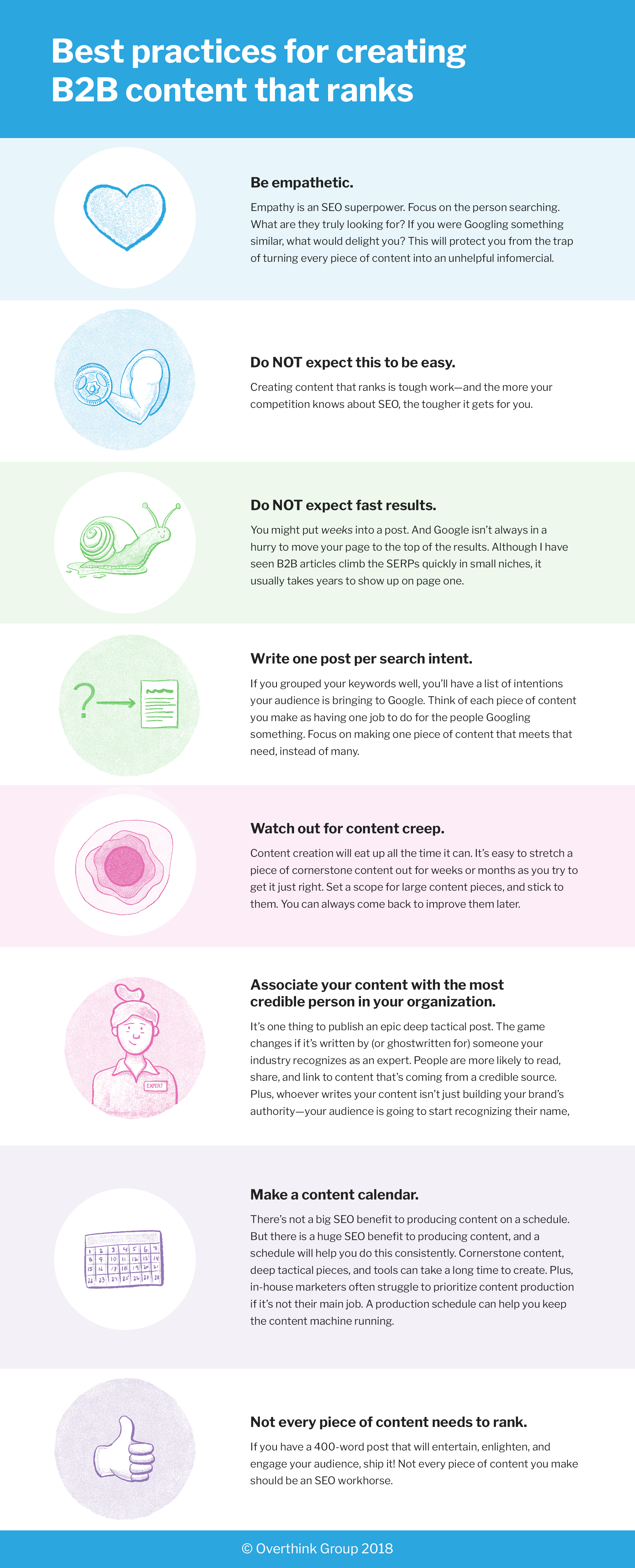
3. “How will we signal quality to search engines?”
In phase one, you discovered what your audience was searching for. In phase two, you made content that can satisfy those searchers.
Most of the hard work is done.
Now you need to check some boxes to help search engines recognize that you created something that will satisfy your audience when they Google those keywords.
If you can do that, then your content will climb those SERPs and start winning all that sweet, sweet B2B organic traffic.
Again, there’s a TON that could be said on this, but if you start by focusing on these areas, you’ll have most of your bases covered.
Publish content by humans, for humans (don’t be an AI SEO junkie)
Google has repeatedly stated that their algorithm is designed to promote human-written editorial content—which means 2024 is NOT the year to outsource your B2B SEO content production to AI. (Besides this, humans generally don’t like reading content that feels like it was machine-written.)
“But Jeffrey, our competitors are churning out hundreds of blog posts a week with AI!”
That’s great for you! If other players in your space are going all-in on AI-generated content, they’re practically inviting you to monitor their content performance and write better, more E-A-T (expert, authoritative, trustworthy) content than they’re cranking out. I’d recommend closely following your competitor’s blogs and running them through an AI checker to see just how human-sounding the machines think it is. If your competitors are ranking with content that smacks of generative AI, you have an opportunity to dunk on them with more natural-sounding (and hopefully more insightful) content of your own.
Build a Link Lattice
One of the smartest ways to begin doing B2B SEO is to build a series of interlinked pages around your product category. By connecting your product pages, pillar pages, and various other page types, you can signal to Google which pages on your site are most relevant to your product category—and rank for that search volume.
I’ve written a guide on exactly how to do this here.
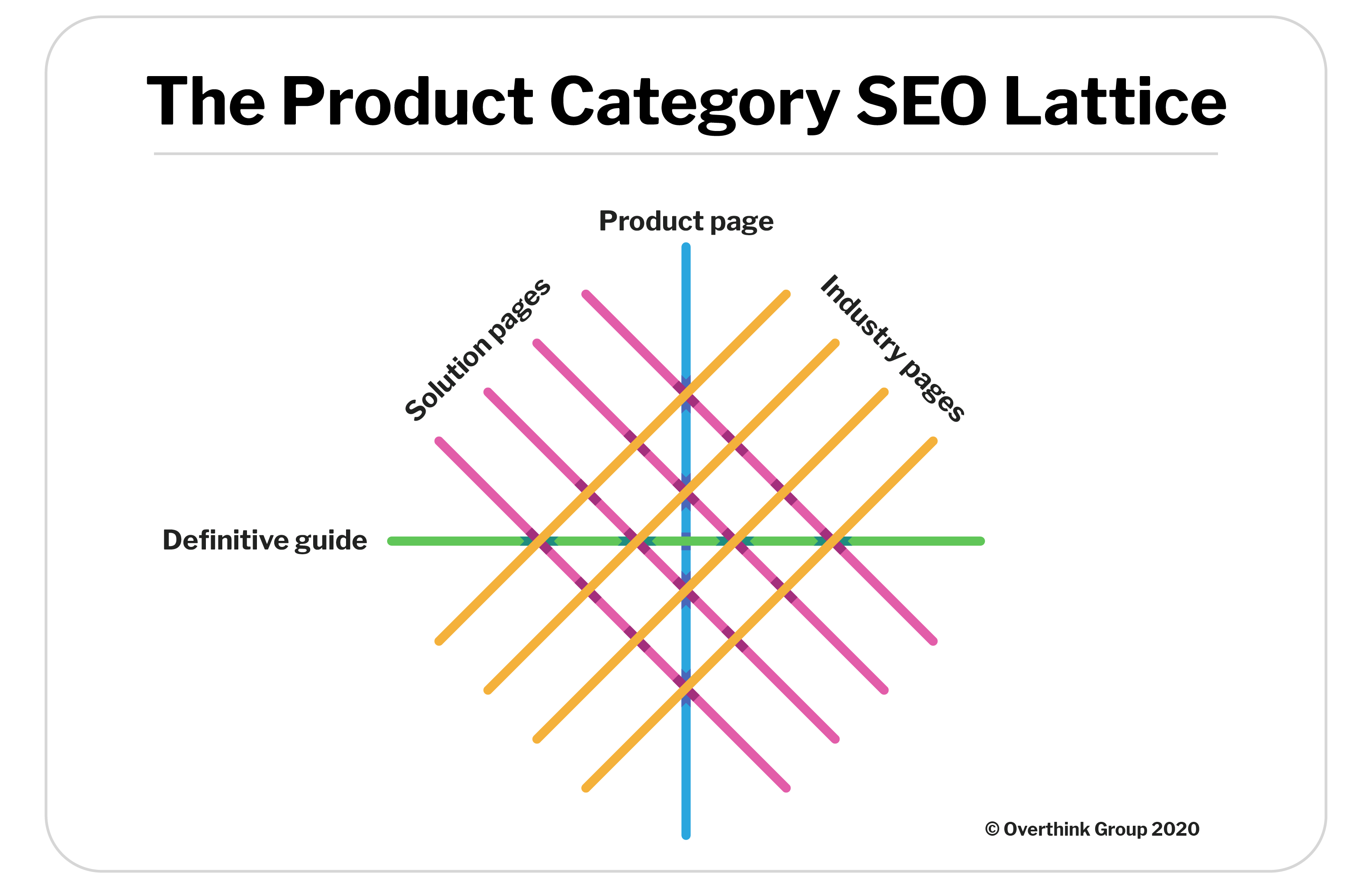
Use related terminology
Google’s getting smarter all the time. It’s not just looking for a specific keyword being used over and over in the content. In fact, you’ll stand a greater chance of ranking by naturally using a wide swath of vocabulary associated with the topic you’re covering.
So if you’re writing a piece on flat roof coverings, you’ll want to mention terms like asphalt, EPDM, modified bitumen, and vinyl.
You’ll get plenty of these related terms straight from your keyword research. But if you want to make doubly sure, scan the table of contents of any related Wikipedia pages. (That’s where I grabbed those flat roof terms!)
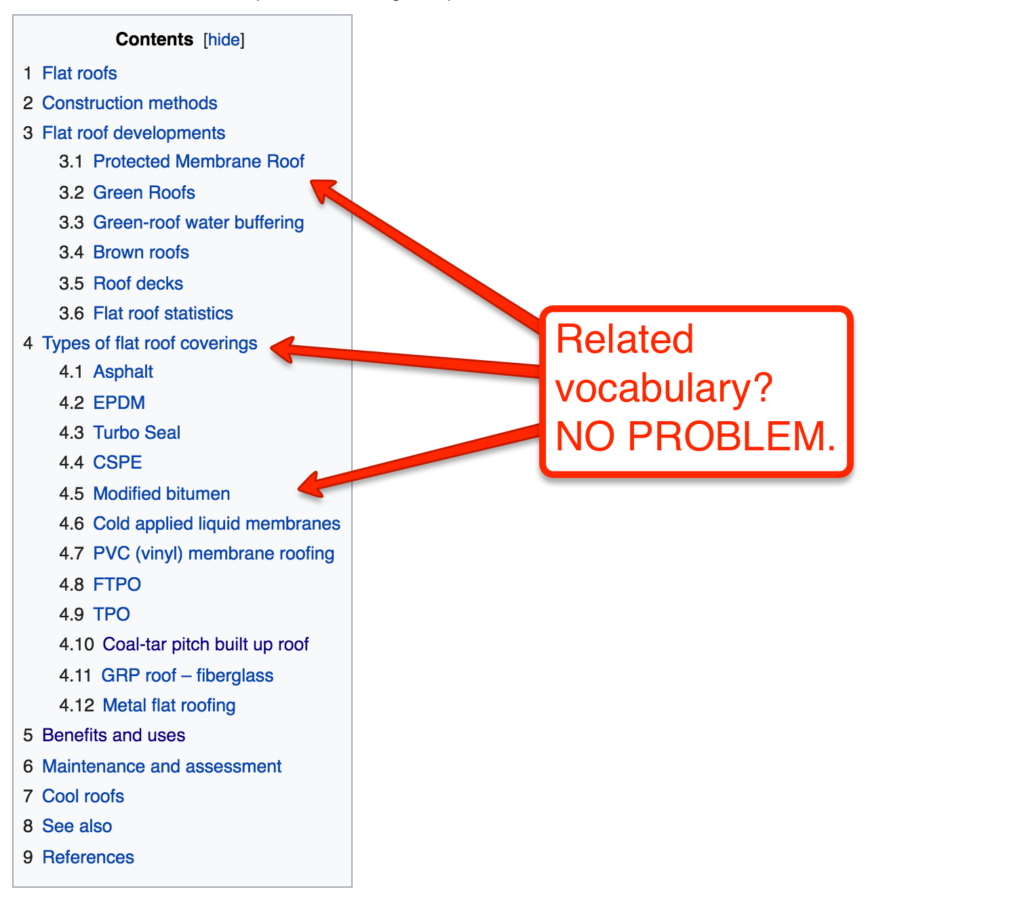
This makes sense when you think about how human conversation works.
Imagine you’re at a local brewery and you overhear two conversations.
In the first conversation, two people talk about how much they love beer. They love dark beer and strong beer and beer that’s not too bitter.
In the second, two people discuss how much they love beer. But one of them prefers IPAs, and the other is more of a pilsner fan. They both enjoy a hoppy taste, they’re not too keen on stouts or porters, but they can tolerate a good winter warmer every once in a while.
Which of those groups would you assume knew more about beer? Probably the latter—specifically because instead of overusing the word “beer,” they’re using specific beer-related terms.
So when you’re writing authoritative content, use authoritative language.
Optimize your SERP clickthrough rate
One thing that influences a page’s ability to rank is click-through rate.
Click-through rate (CTR) = what percentage of people who see your link in the SERPs click on it
A few ways you can make your links more clickable:
- Write a compelling title. “Lead generation” is a lot less interesting than “Lead Generation: Everything You Need to Know”
- Keep your URLs simple, readable, and relevant. Remember, your B2B audience is probably using a work computer (or even a work mobile device). Your audience is going to feel a lot safer going to a webpage like com/hvac-cost-calculator than Yoursite.com/p8074gg00z=004
- Monitor page performance in Google Search Console. Keep an eye on which keywords translate to clicks—and if you notice that a page is showing potential with a keyword that isn’t in the title, consider adjusting the title to incorporate that keyword.
Build links to your content
One of the best ways to tell Google your content is worthy of organic traffic is to get other websites to link to it. This process is called link building.
Links work in B2B SEO similarly to how word of mouth works in real life. You’re more likely to try a new product, watch a movie, or visit a vacation destination if you’ve heard other people talking about it. The more people you hear talking about how much fun they had in Iceland, the more you want to go to Iceland.
Google works in a similar fashion. If hundreds of websites link to a piece of content you published, Google takes that as a clue that the content is good. (It must be, if all these people are willing to send their readers to another site for it.)
There are several ways you can build links to your content—and they all come down to promoting the content you produce. The specific promotion tactics you use will vary depending on the specific piece of content you’re promoting. However, you will almost always want to do the following:
- Tell your email list about new content (and ask them to share it)
- Reach out to influencers to let them know about it
- Add an email about that content to any relevant automated drips
- Expert-level: conduct original research and publish statistics—these are the things that journalists and bloggers love to link to!
In terms of advanced tactics, Backlinko.com is a fantastic resource. Brian Dean is one of the best in the business when it comes to link-building, so I highly recommend checking out these tutorials from him:
You can find plenty of tactics for building links to your content online, but there’s really just one principle that you absolutely need to take to heart: attention begets attention. It’s far easier to get visits, links, and shares by telling your existing audience about your content than it is to make every piece of content win its own audience.
So when you make a new post, promote it to your subscribers, your employees, your customers—anyone who might find it relevant and valuable.
Wrapping up
If you’ve made it this far, you have enough working knowledge to start doing your own B2B SEO. Remember: there’s a lot of nuance to this discipline, and so there’s always more to learn and explore. But you’ll be heading in the right direction if you’re constantly doing one of these three things:
- Discovering what your market is searching for
- Creating content that can satisfy their searches
- Convincing Google that your content can satisfy their searches
Make a strategy. Do great research. Write stellar content. Set it up to win.
And watch the organic traffic pour in.
(And if you’d like a hand at getting started with this, let’s talk about it.)



this is the best article about B2B website seo and marketing.